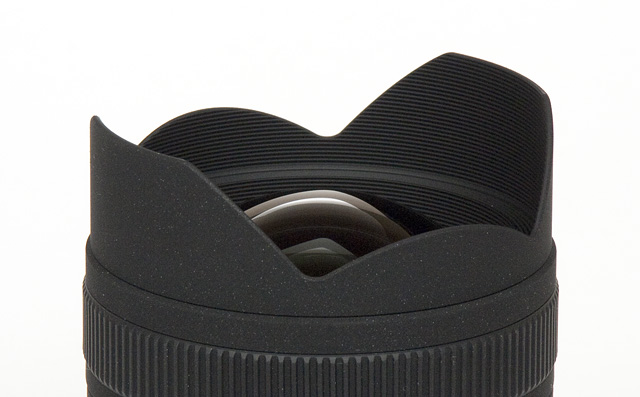|
Sigma AF 8-16mm f/4.5-5.6 DC HSM - Lab Test / Review |
|
Lens Reviews -
Canon EOS (APS-C)
|
|
Page 1 of 2 
Review by Klaus Schroiff, published May 2010
Introduction
Sigma is the largest independent lens manufacturer of the world (family owned, BTW) yet they're not present in all lens segments. However, they've a couple of sweet spots and ultra-wide angle lenses is one of them with no less than 4 zoom lenses. Their latest addition (as of the time of this review) is the Sigma AF 8-16mm f/4.5-5.6 DC HSM. Besides being the most extreme rectilinear ultra-wide lens on the market it is also the first one to sport Sigma's latest new innovation - FLD glass elements. FLD glass is supposed to deliver a similar characteristic like fluorite glass which is only used in a handful of expensive lenses to correct color aberrations and the Sigma AF 8-16mm f/4.5-5.6 DC HSM has 4 of 'em. It is a dedicated APS-C lens with a field-of-view equivalent to a 12.8-25.6mm full format lens. As such it can be regarded as an updated APS-C version of the full format Sigma AF 12-24mm f/4.5-5.6 EX DG HSM.
 Such ultra-wide lenses with a "bulb"-like front element have not been very popular for a long while. After all it's not possible to mount front filters here. However, the design has seen a bit of revival since the Nikkor AF-S 14-24mm f/2.8 ED showed that such lenses can be vastly superior to conventional flat-front element ultra-wide lenses. Whether you like such a vulnerable front element or not is a different question of course. To be fair - the "bulb" of the Sigma is -fairly- well protected by the fixed petal shaped hood. The front cap cannot be mounted to the hood directly - there's an additional "tube" that can be attached to the lens. You may hope that this tube can remain mounted at least for the 16mm setting but you'll run into edge shading here - it's an extreme ultra-wide lens after all.
Such ultra-wide lenses with a "bulb"-like front element have not been very popular for a long while. After all it's not possible to mount front filters here. However, the design has seen a bit of revival since the Nikkor AF-S 14-24mm f/2.8 ED showed that such lenses can be vastly superior to conventional flat-front element ultra-wide lenses. Whether you like such a vulnerable front element or not is a different question of course. To be fair - the "bulb" of the Sigma is -fairly- well protected by the fixed petal shaped hood. The front cap cannot be mounted to the hood directly - there's an additional "tube" that can be attached to the lens. You may hope that this tube can remain mounted at least for the 16mm setting but you'll run into edge shading here - it's an extreme ultra-wide lens after all.
 The build quality of the Sigma lens is very good - it's mostly made of tightly assembled metal parts. The two control rings have a smooth, pleasant action. The physical length of the lens remain constant regardless of the zoom and focus setting. However, the inner lens tube moves a little during zooming. The lens is also fairly unusual with respect to its dimensions - ultra-wide lenses tend to be fairly short with a large diameter whereas the Sigma is comparatively long at more than 10cm and a total diameter of "only" 75mm.
The Sigma features a HSM - a "hypersonic AF motor" which is very fast and nearly silent. The AF speed via in contrast AF (Live-View) is about average. Full-time manual override is always possible in one-shot AF mode.
The build quality of the Sigma lens is very good - it's mostly made of tightly assembled metal parts. The two control rings have a smooth, pleasant action. The physical length of the lens remain constant regardless of the zoom and focus setting. However, the inner lens tube moves a little during zooming. The lens is also fairly unusual with respect to its dimensions - ultra-wide lenses tend to be fairly short with a large diameter whereas the Sigma is comparatively long at more than 10cm and a total diameter of "only" 75mm.
The Sigma features a HSM - a "hypersonic AF motor" which is very fast and nearly silent. The AF speed via in contrast AF (Live-View) is about average. Full-time manual override is always possible in one-shot AF mode.

| Specifications |
|---|
| Equiv. focal length | 13-26 mm (full format equivalent) |
| Equiv. aperture | f/7.2-f/9 (full format equivalent, in terms of depth-of-field) |
| Optical construction | 15 elements in 11 groups inc. 3x aspherical, 1x SLD and 4x FLD elements |
| Number of aperture blades | 7 |
| min. focus distance | 0.24 m (max. magnification ratio ~1:7.8 @ 16 mm) |
| Dimensions | 75 x 106 mm |
| Weight | 555 g |
| Filter size | - |
| Hood | fixed, petal shaped |
| Other features | - |
|